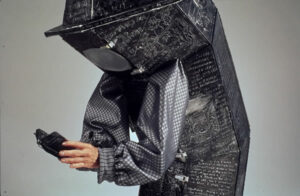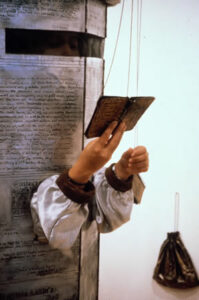The Architecture of Migration, Rearranging the House (2000) is the first in a series of wearable structures that both connect and disconnect their inhabitant with the exterior world. The initial piece was created while doing a residency at the Banff International Centre and came out of a rather pretentious discussion of the Lacanian struggle between presence and absence. The work explores identity, dislocation and border crossings: public/private, rural/urban, poverty/privilege, male/female.
The exterior metal skin is covered with text from U.S. government travel alerts, Canadian nationalist websites, my mother’s travel diaries, notes from homeless teens, and directions from the Encyclopedia of Crafts. The viewer can enter the structure and become a performer by extending arms through the provided sleeves and peering out a screened opening to read any one of seven metal books hanging from a rotating elevated hoop. This process is an intentionally awkward one. Overall the form resembles that of an enormous baby bottle.
The interior of Migration is a warm copper incised with text and marks made by a hospitalized woman while on a respirator (near death). There are two 2″ video monitors embedded in the exterior walls. The vides show an erotically charged close-up of thumb rubbing circles into flesh, a hand covering a mouth, and a couple learning the Foxtrot. Related to The Architecture of Migration is Pillows, a series of twenty hand-fabricated aluminum pillowcases (with feather pillows from a convent inside) resting against the gallery wall in rows. One pillow has a tiny 2-inch monitor with video.
This work took on new meaning for me when it opened at a gallery in New York on September 10, 2001. The following day I watched the events of September 11th unfold from my window several blocks north of the World Trade Center.
The Architecture of Fatigue (2003-4) is the second in my wearable structures series sometimes referred to as Containers for the Self. The seven-foot wood structure is covered with text incised on 36-gauge aluminum. One enters the structure under very awkward contorted conditions. The wearer must take the drooping posture of this bent over form, extending arms into its dangling sleeves.
Superficially based on psychological research showing that physical posture as well as facial gesture can affect mood, the piece responds to the personal and cultural sense of “overload” that has come with our post-industrial era. Again the wearer can connect with the external world only through touch and obscured vision. Covered with text and images from early twentieth through twenty-first century ads, one sees remedies and contraptions designed for energy restoration. In a pocket under one sleeve are several small metal artists books including Ann Sakaguchi’s The Eye Bag Chronicles as well as excerpts from Rest Room Worlds. Three two inch video monitors in the “skirt” of the structure reveal loud, almost erotic, moaning and show the artist’s hand rubbing her face and eyes in close-up. Ironically the structure appears in a passive, submissive posture of exhaustion, yet when an arm suddenly moves to touch someone, viewers jump back in horror.












